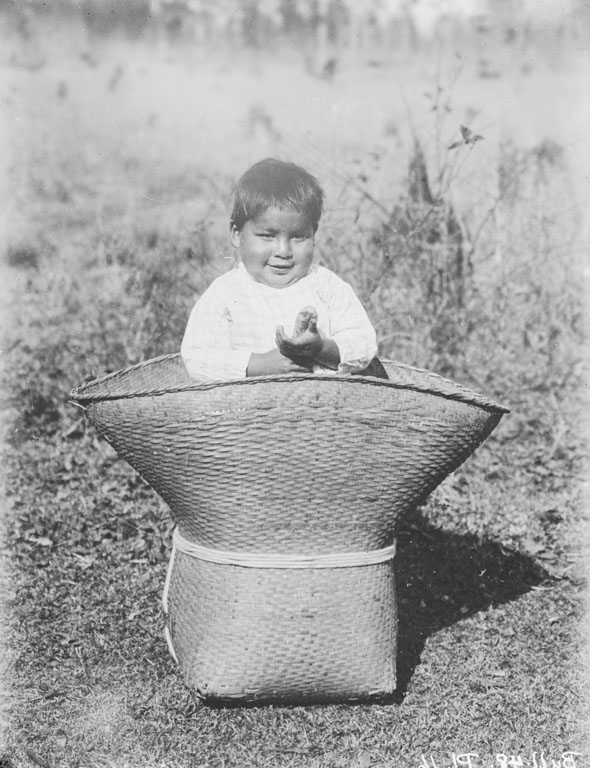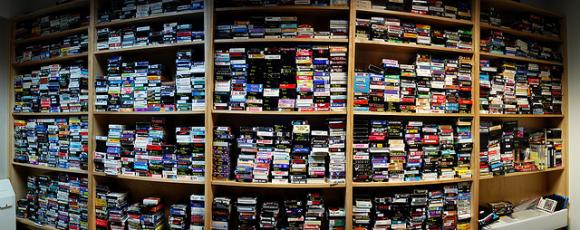On Thursday, October 22nd, four of our archivists/conservators were available on the Smithsonian's Facebook page to answer questions about preserving your own archival collections. The four archivists at the Q&A have specialties in the preservation and organization of audio/visual material, photos, and digital records (email, digital video, etc.) This is our fifth year hosting this event we received some really interesting questions this year. If you don't see the question you have, check out our past Q&A's, or reach out to us in our forums. We enjoy getting to hear from you through this fun event each year!
Q: To kick things off, please introduce yourself and tell us your favorite item in the Archive.
A: Hi Everyone, I'm Eden Orelove, contract photographer at the Smithsonian National Anthropological Archives (NAA). My academic and professional background is in photography, including the history of photography, and the preservation and access to collections. One of my favorite images from our archives is of a two-year old Choctaw boy sitting in a basket. Taken in 1909, it was produced by the Bureau of Ethnology, the foundation of NAA's collection.

A: Welcome everyone. I am Lynda Schmitz Fuhrig from the Smithsonian Institution Archives. I am the electronic records archivist who specializes in born-digital materials from across the Smithsonian. This includes images, video, audio, email, and text records. We have lots of cool things in our archives but one of my favorites is the draft of James Smithson's will. Smithson, who actually never came to the United States, was the founding donor of the Smithsonian. My colleague Nora Lockshin, who is here today as well, wrote an interesting blog post here: Smithson's Draft Will: A Case for Handwriting.
A: Hi folks! Michael Pahn, head archivist at the National Museum of the American Indian, here to answer any questions you have about caring for your archival collections. My background is in audiovisual materials, but here at NMAI we have an amazing collection of historic photographs, manuscripts, film, and more. I'm proud to report that we recently put our first fully digitized archival collection online. Check out the Thomas Henry Tibbles papers and learn all about the Standing Bear habeas corpus trial and the birth of the Native American civil rights movement.
A: Hi there, I'm Nora Lockshin, senior conservator for the Smithsonian Institution Archives. As for my favorite thing, this year, what's cooler than being cool? ICE COLD! We are SO excited to have a new cold storage facility coming online next month for the Smithsonian Institution Archives' photographic collections! It is gorgeous in there, due to the careful planning and hard work of my colleagues!
Q: We had an early question come in yesterday about what to do with microfilm that smells like vinegar.
A: Nora - Microfilm that smells like vinegar is suffering from deterioration or "vinegar syndrome". The degree of deterioration can be tested with test strips. There's a really good summary over at Image Permanence Institute, with links to their guide that explains what is going on, guidelines for testing, and solutions for managing film collections. If your microfilms are published access copies for general use, you might want to think about budgeting for replacement of these access films from their preservation master, if at all possible for your facility. If they are originals, you're going to want to think about solutions for slowing their deterioration in cool or cold storage, and imaging duplication (aka reformatting) to a new preservation master format.
Q: I have some voicemails I'd like to save - What's the best way to get them off my cell phone and preserve them? Since I upgrade laptops and phones every few years, where's the best place to store them?
 A: Michael – This is an interesting question. It's going to take a little bit of technical know-how, but if you have a computer with an audio line-level input this may not be too difficult. You'll need a couple of things: first, a way of recording audio on your computer - there are many applications that do this, including open-source programs that are freely available. You'll also need a mini-to-mini cable - it should have small jacks like your headphones have, but at both ends. Plug the cable into the headphone jack on your phone and the audio input on your computer. Open your audio recording program, and make sure your voicemail audio is audible to the program. There are probably some settings that you will need to adjust, like the line input level. Once you can hear your phone's audio in the application, just record the audio as the voicemail plays back. At that point you should preserve it as you would any other digital audio file. Here's some guidance on that from the Library of Congress. Good luck!
A: Michael – This is an interesting question. It's going to take a little bit of technical know-how, but if you have a computer with an audio line-level input this may not be too difficult. You'll need a couple of things: first, a way of recording audio on your computer - there are many applications that do this, including open-source programs that are freely available. You'll also need a mini-to-mini cable - it should have small jacks like your headphones have, but at both ends. Plug the cable into the headphone jack on your phone and the audio input on your computer. Open your audio recording program, and make sure your voicemail audio is audible to the program. There are probably some settings that you will need to adjust, like the line input level. Once you can hear your phone's audio in the application, just record the audio as the voicemail plays back. At that point you should preserve it as you would any other digital audio file. Here's some guidance on that from the Library of Congress. Good luck!
A: Lynda - You should store them on a computer that you back up regularly onto something like an external drive. You will want to check a copy of them periodically to make sure you can still listen to them.
Q: So what can I do to preserve those VHS tapes of ballet recitals?
A: Lynda - You should get those VHS tapes digitized and store the digital copies in multiple places. See the Library of Congress for some additional information.
A: Michael - To ensure that your videotapes are playable, they need to be stored someplace with stable temperature and humidity. Fluctuations in climate can really speed up the deterioration of a/v materials like videotape. The tapes should be stored in cases, on end like books. Keep them on shelves, not on the floor (just because the floor is more likely to heat up and cool down than shelves are). Here's a link to a great, easy to read resource on videotape preservation from the National Film & Sound Archive of Australia.

Q: I recently came across some books I had when I was a kid stored in the basement of my parents house. The box must have gotten wet/damp at some point because it looks like there is some mold (black spots?) on the pages of some of the books. Is there a way to remove those? How should I store books and papers and the like so it doesn't happen again?
A: Nora - Hi there Becky! We have a few tips on our Collections Care Forum and our website on recovery of papers and books. Most importantly - you have to think about your health and anyone who may be using the books in the future, as mold can cause allergic reactions and worse. With children's books that might be easily replacable, do consider discard and purchase of like copies, or potentially at least have them evaluated by a book conservator to see if they can be treated. If they are unique for sentimental or antiquarian value, proceed to our Q&A Forum to learn more, and the links within to find more we've written both on our blog and in our Disaster Preparedness, Response and Recovery resource page. Through the Disaster page, you'll find links to more info about disaster response vendors and Preparedness precautions you can take in the future to prevent more damp books, starting with don't keep precious things in the basement, or near sources of water or heat. (But if you have to, at least keep them a few inches off the floor, boxed and on shelves!)vIt sounds like your books are dry now, but for wet or damp books, our friends at the Library of Congress just released a terrific video on how they deal with wet and moldy books. We'll be adding it to our Disaster page shortly.
Q: When my mother passed away, I inherited her wedding dress (married 1966) and the dress from my great-grandmother (married 1910). Neither had been stored correctly and so both are damaged from age: yellowed, falling apart in places. Is it possible to preserve them now so that they don't get worse? Or is it too late?
A: Nora - It's lovely that you have them and wish to care for them! Try these resources that have been specifically developed for textiles over on our Museum Conservation Institute's Taking Care page, specifically Tips on How to Handle Antique Textiles and Costumes among other articles (scroll down the menu on the right!). Elsewhere, the Minnesota Historical Society has a great tips sheet and a series of video tutorials on care of textiles. For another quick read, our colleague Sarah Scaturro (formerly of our Smithsonian Cooper Hewitt National Design Museum) at the Costume Institute of the Metropolitan Museum of Art was quoted in the New York Times. There's a very brief video there too, but I suggest also watching the longer series from Minnesota.
Q: I have a dozen historic negatives of Native Alaskans from 1900-05 by a little known photographer. I would like to restore them digitally. How can I find out if these images are already in NMAI's archives?
A: Michael - Only a small percentage of NMAI's photographic collections are available online at this time, but you can find them by searchinghttp://collections.si.edu. Enter a search term and limit your results by "catalog record source" to see just the photos from NMAI. Needless to say we have many, many thousands more photos in our collection that are not yet publicly available online. To learn more about these, and to find out if we have images like the ones you own, please email your inquiry to NMAIPhotos@si.edu. As for digital preservation and restoration of your negatives, here's a great Q&A from the New York Times written by a colleague from the Library of Congress. Good luck!
A: Eden - There are some useful links to more information about digitization and digital preservation at the bottom of this Smithsonian Institution Archives page. Also, remember that the National Anthropological Archives holds many negatives and photographs of Native Americans.
A: Lynda - If you do opt to get a digital version, which I recommend, be sure to have a multiple copies of it. You want it to be the highest resolution possible. We consider TIF to be the preservation format while a JPG can serve as an access copy to share.
Q: I have a collection of vintage radio controlled car manuals. Most of them are B&W printed on what is akin to either construction paper, and/or thin parchment paper. Most are staple bound while one or two are glued. Any suggestions? How should i handle display (preferred) and storage?
A: Nora - This sounds like a really fun collection, Schuyler! For display of books, we prefer not to display them open or closed for long periods of time, as covers and prints can fade or darken, but generally advise short periods of display, under conditions that protect them from ultraviolet and extremes of temperature and humidity that can distort bindings and thin parchment-like paper. Books left open can "remember" their opening page in the spine and start breaking down the structure. Ideally if you want to display a book, support it on soft pillows or angled supports, such as are seen here in this terrific blog post by our own William Bennett.
Further, our former colleague Kirsten wrote up a great tip on imaging historic books, including some info on copyright, for you to consider imaging and printing facsilmiles for framed display or even use, should you have any of the actual little cars. If the manual is staple bound on the side (as opposed to "through the fold", in the center spine of the paper sections, it is harder to open for imaging or display, and can lead to breakage and loss of pages. Same goes for books that are glued up "perfect binding" style, without any sewing. Books don't like to be pressed flat and open on a flatbed scanner or copier! Consider consulting with a book conservator (see this link to find a conservator) to see if the books can be safely disbound and rebound to allow for single or double leaf imaging on a flatbed if not with an overhead digital camera - but then you are really intervening with the historic structure of the book - an ethical decision for both you the owner, and the conservator.
Q: What is the best advice you can give to someone looking to get into the museum/archivist field?
A: Effie - Great question! We've written a blog post about becoming an archivist. Definitely see if you can volunteer or intern at a museum, archive, library, or historic society to give it a try.
A: Eden - I would also recommend talking to practicing archivists about their jobs and the archives they work at. It helps to know what the "day in the life" of an archivist consists of. Best of luck!
Q: I have a couple of old documents, the one I am concerned about is a first communion doc from about 1894 for my great grandmother. It is about 10x12 size. My grandmother kept it in a box but folded up. It is in bad shape especially where folds were and she used scotch tape to keep together. How can I remove this and what can I use in its place?
A: Nora - We don't suggest removing the tape on your own, as it could easily take inks, or more paper away with it. Here is a note we wrote up about tape specifically on a photograph, but also applies to your document. Also, sometime in October as part of #archivesmonth, or in April during #preservationweek especially, libraries, archives and historical societies sometimes host open clinics for people to consult with experts, or offer other lectures on preservation! We do suggest that you consider finding a conservator, and definitely take steps to house it in an proper, labeled enclosure so that it doesn't get lost and you don't handle the actual document as much, but instead handle the folder to look at it and protect it in storage. Here is a link on how to find a conservator to consult with you.
 Q: How do you get still-sticky glue off of the feet of plastic Star Wars action figures without hurting the plastic? And, would you recommend paper or plastic containers for storing plastic objects?
Q: How do you get still-sticky glue off of the feet of plastic Star Wars action figures without hurting the plastic? And, would you recommend paper or plastic containers for storing plastic objects?
A: Nora - What a timely question for all those Star Wars fans and collectors out there! I'm not exactly familiar with the substance used for action dolls. If these are new figures right out the packaging and the glue is anything like the weird clear sticky goo that bulk mailers are using to attach credit and coupon cards these days, I'm super curious about it too. I keep meaning to bring some in from home and analyze it, so stay tuned. That said, if it rolls off and sticks to itself with a little rubbing and rolling with your finger, without removing paint or texture, try that, or using a cotton swab to see if you can get it off in tiny motions. However, if the figurines are older vintage objects (say over 10+ years old), the plastic may be decomposing on its own, and the only answer is proper storage and a cooler environment. Plastics are a sticky issue indeed - more on the most recent collaborative international research in preservation of plastic artifacts can be found here. The glue and the coating/paint or plastic may be deteriorating via oxidation or hydrolysis. I'm sorry about that. Cold storage in a limited anoxic environment apparently worked for Han Solo.
And, the never-ending question, "will that be paper or plastic, ma'am?"! Its a great question, because different plastics degrade differently. Some might be more affected by humidity, some by oxygen, and some decompose in a way that if their offgassing or leaching components aren't allowed to diffuse, increase the rate of deterioration. If you can identify or characterize the plastic(s), you can get to the best solution for your items more easily. The brilliant Yvonne Shashoua breaks it down for you here, via the Getty Research Institute, a partner in the PoPArt project. And note, you don't always need fancy technical equipment to ID plastics - there are sometimes visible production marks and types of objects that trend to one type of plastic or another.
Produced by the Smithsonian Institution Archives. For copyright questions, please see the Terms of Use.

Leave a Comment